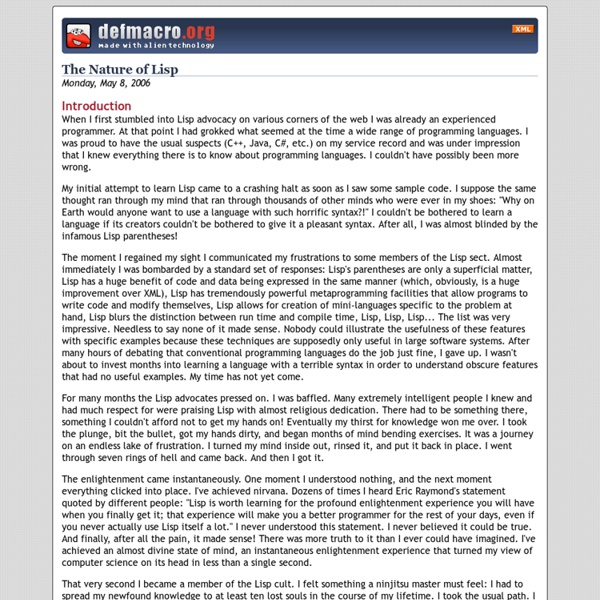The Nature of Lisp

Our new build status indicator - GitHub
date
Most spreadsheet programs have a rather nice little built-in function called NETWORKDAYS to calculate the number of business days (i.e. Monday-Friday, excluding holidays) between any two given dates. I couldn't find a simple way to do that in PHP, so I threw this together. It replicates the functionality of OpenOffice's NETWORKDAYS function - you give it a start date, an end date, and an array of any holidays you want skipped, and it'll tell you the number of business days (inclusive of the start and end days!) between them. I've tested it pretty strenuously but date arithmetic is complicated and there's always the possibility I missed something, so please feel free to check my math. The function could certainly be made much more powerful, to allow you to set different days to be ignored (e.g. <? function networkdays($s, $e, $holidays = array()) { if ($s > $e) return networkdays($e, $s, $holidays); $sd = date("N", $s); $ed = date("N", $e); // Calculate net working days. return $nwd; } ?
Setting up a MSysGit Server with copSSH on Windows
OK – let me start this post by saying this is absolutely NOT for the faint hearted. This was a serious – and I re-emphasize this – serious pain in the arse to the do. Having almost no experience in Linux before – copSSH emulates the Linux environment through cygwin – let me tell you that this process was not easy. If you are an expert and thought – “pfftt, this process was easy” – I will reserve my language and ask you to kindly move along :) For those of you with no clue at all (ala me) – then this post is for you. Firstly, full credit goes to the fantastic team at msysgit – these guys rock for porting GIT to Windows – GIT is an unreal DVCS and so I cant thank them enough for making this all possible. Finally, if this process worked for you – please leave a comment telling me (and everyone else) that it works and share this article around. Update 2: You can still use copSSH 3.0.3 as it’s free. Pre-setup Step 1 – Installing copSSH Step 2 – Setup copSSH Step 3 – Installing PuTTY Problem Guide
Structure and Interpretation of Computer Programs
This book is one of a series of texts written by faculty of the Electrical Engineering and Computer Science Department at the Massachusetts Institute of Technology. It was edited and produced by The MIT Press under a joint production-distribution arrangement with the McGraw-Hill Book Company. Ordering Information: North America Text orders should be addressed to the McGraw-Hill Book Company. Outside North America All orders should be addressed to The MIT Press or its local distributor. © 1996 by The Massachusetts Institute of Technology Second edition All rights reserved. This work is licensed under a Creative Commons Attribution-Noncommercial 3.0 Unported License. This book was set by the authors using the LATEX typesetting system and was printed and bound in the United States of America. Library of Congress Cataloging-in-Publication Data Abelson, Harold Structure and interpretation of computer programs / Harold Abelson and Gerald Jay Sussman, with Julie Sussman. -- 2nd ed.
Building a Glider Gun with SQL Anywhere | Peering Behind the Browser - Pentadactyl
This one is a little fun for a Friday: implementing Conway’s Game of Life in SQL Anywhere 12. The game of life is a simple zero-player game where an infinite plane of cellular automatons live and die according to some simple rules. In this post, we will create a full version of this game (with GUI), in a single SQL statement. Taken from Wikipedia , the rules of Conway’s Game of Life are: The universe of the Game of Life is an infinite two-dimensional orthogonal grid of square cells, each of which is in one of two possible states, live or dead. It is unlikely that SQL would be your first choice for building an instance of the game of life. Spatial support to hold the polygons that make up the world Spatial viewer inside of Interactive SQL to view the current state of the world Spatial functions to provide some mutations of the world Select from DML, enabling you to use the results of a DML statment as a derived table The first thing to do is create a table to hold the state of the world.
Related:
Related:




superbe article sur l'intéret de Lisp (code & données, macros) by bernadrian May 2